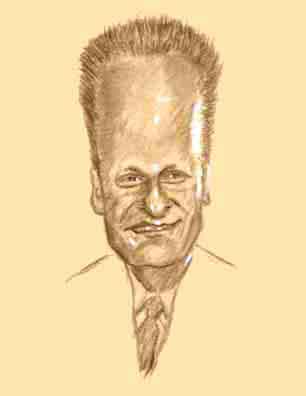Hans Bethe
1906 - 2005

Hans Bethe made one of the most important discoveries in the history of science. Naturally upon hearing what Hans wrought, your Mr. Average on the street will shrug his shoulders, flip on the remote, take another swig of his Bud Lite, and continue watching the playoffs.
What Hans discovered was that in massive stars (that is, bigger than the sun), carbon - good old fashioned carbon (what this drawing was made from) - steps in as a catalyst to power the fire. It's not just simply smashing hydrogen together to form helium (although ultimately that's what happens). Therefore the star could burn far easier - and longer - than the piddly few million years it would burn without the now-called carbon/nitrogen cycle.
Hans, whose mother was Jewish, left Germany in 1933. However, his mom couldn't get out without paying a $250 fee, technically speaking to release her furniture. Hans had submitted his paper about the carbon cycle to The Physical Review but he learned there was a $500 prize for the best "unpublished" paper in physics. So he asked the editor to send the paper back. He won the prize and sent the money to his mom so she could get out.
Largely credited with making Cornell a major department in physics, Hans was head of the physics division at Los Alamos for the Manhattan Project in World War II. After the war he became a moderating voice in the debate on nuclear development. Theoretical work on the hydrogen bomb should continue, he thought, and with the how-to knowledge in place, the West should negotiate with the Soviet Union to stop the actual building and manufacture of the arsenals. Would it have worked? Probably not, but it was a good enough idea.
Like most of the world class scientists, Hans could never retire and kept working well into his 90's. In the last decade of the 20th century, he kept right on doing calculatons - on a slide rule.
References
The Making of the Atomic Bomb, Richard Rhodes, Simon and Schuster, (1987). Hans was a major source for this book and features prominently.